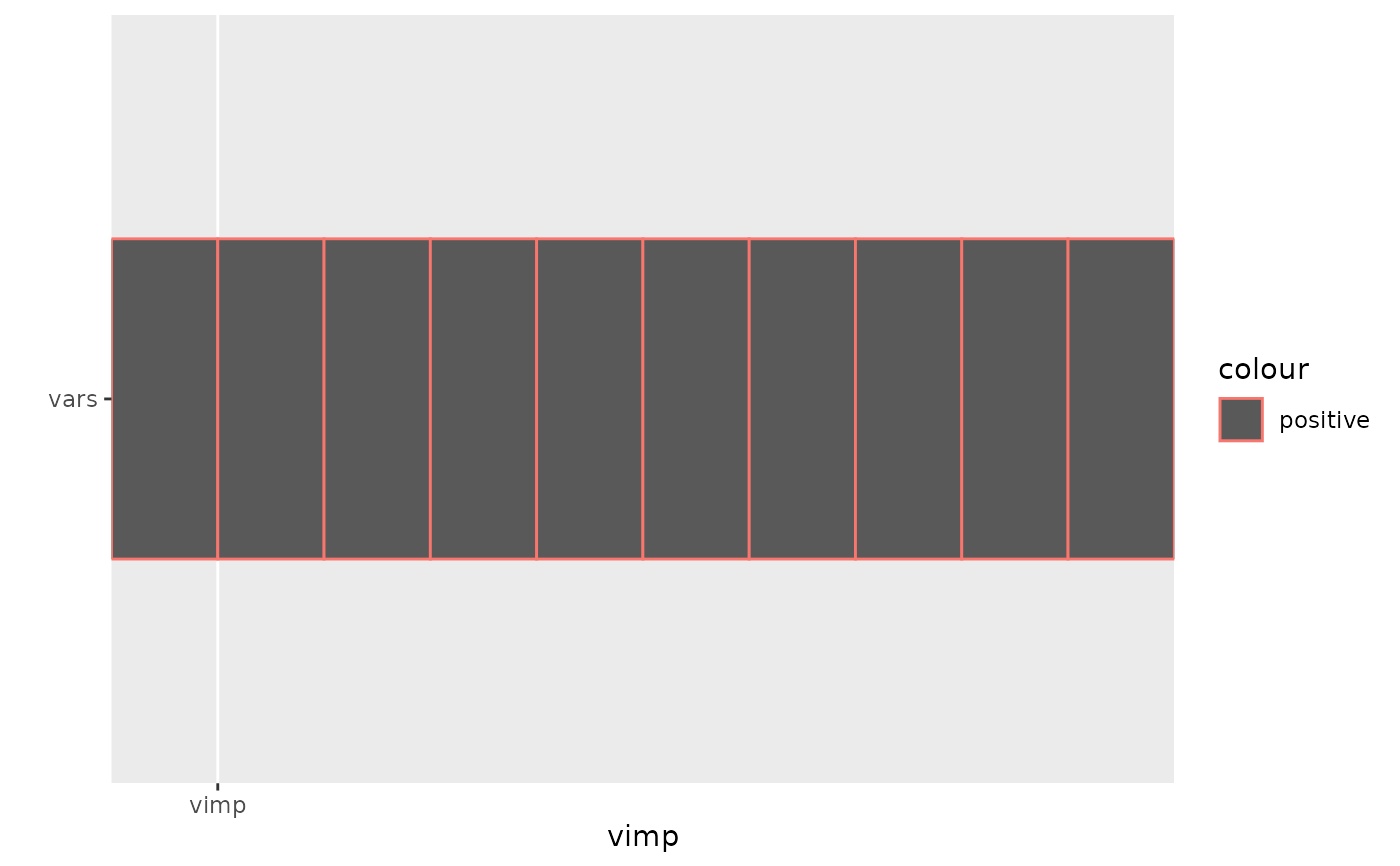gg_vimp Extracts the variable importance (VIMP) information from a
a rfsrc object.
Arguments
- object
- nvar
argument to control the number of variables included in the output.
- ...
arguments passed to the
vimp.rfsrcfunction if therfsrcobject does not contain importance information.
References
Ishwaran H. (2007). Variable importance in binary regression trees and forests, Electronic J. Statist., 1:519-537.
Examples
## ------------------------------------------------------------
## classification example
## ------------------------------------------------------------
## -------- iris data
rfsrc_iris <- rfsrc(Species ~ .,
data = iris,
importance = TRUE
)
gg_dta <- gg_vimp(rfsrc_iris)
plot(gg_dta)
#> Warning: All aesthetics have length 1, but the data has 16 rows.
#> ℹ Please consider using `annotate()` or provide this layer with data containing
#> a single row.
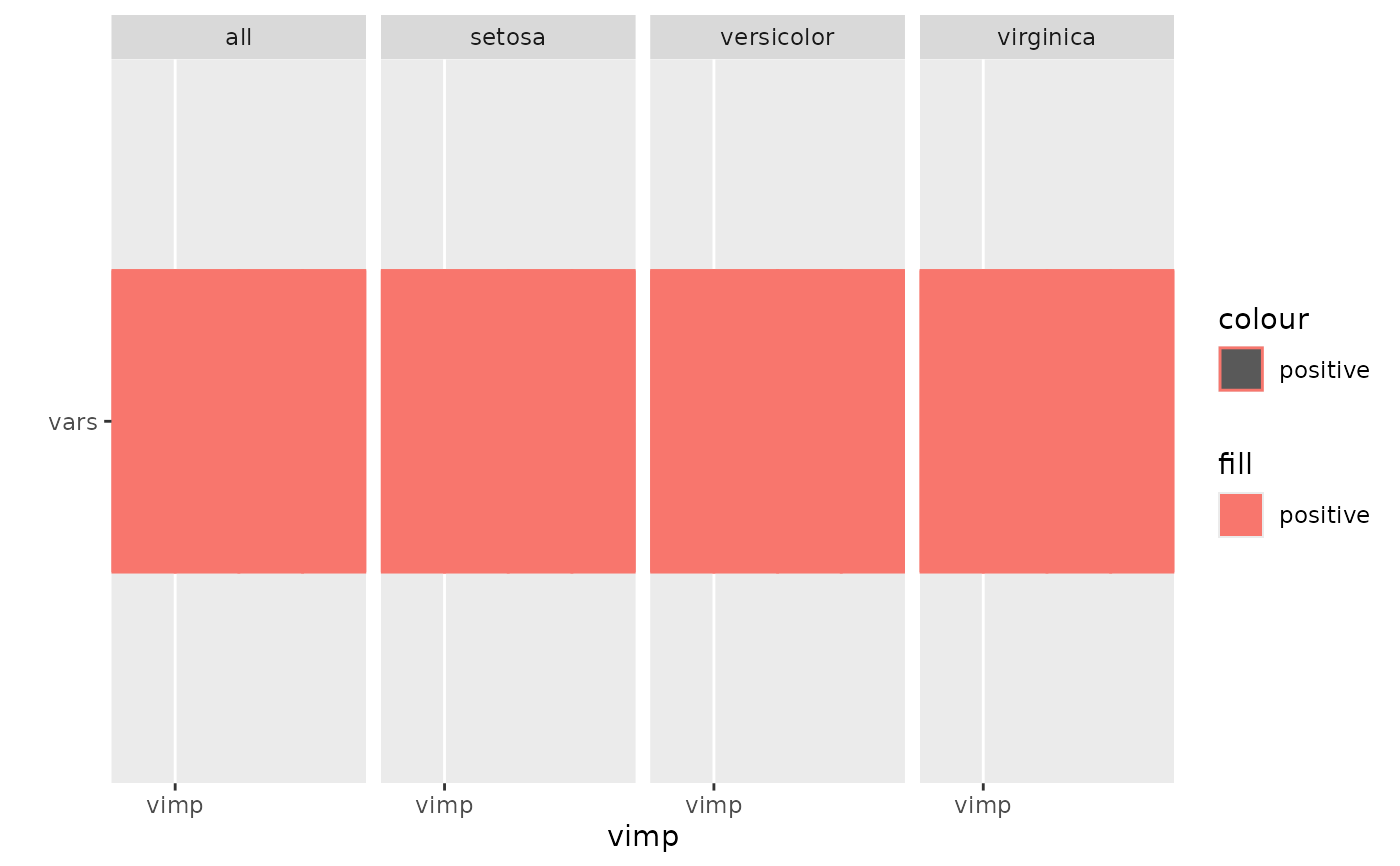 ## ------------------------------------------------------------
## regression example
## ------------------------------------------------------------
## -------- air quality data
rfsrc_airq <- rfsrc(Ozone ~ ., airquality,
importance = TRUE
)
gg_dta <- gg_vimp(rfsrc_airq)
plot(gg_dta)
#> Warning: All aesthetics have length 1, but the data has 5 rows.
#> ℹ Please consider using `annotate()` or provide this layer with data containing
#> a single row.
## ------------------------------------------------------------
## regression example
## ------------------------------------------------------------
## -------- air quality data
rfsrc_airq <- rfsrc(Ozone ~ ., airquality,
importance = TRUE
)
gg_dta <- gg_vimp(rfsrc_airq)
plot(gg_dta)
#> Warning: All aesthetics have length 1, but the data has 5 rows.
#> ℹ Please consider using `annotate()` or provide this layer with data containing
#> a single row.
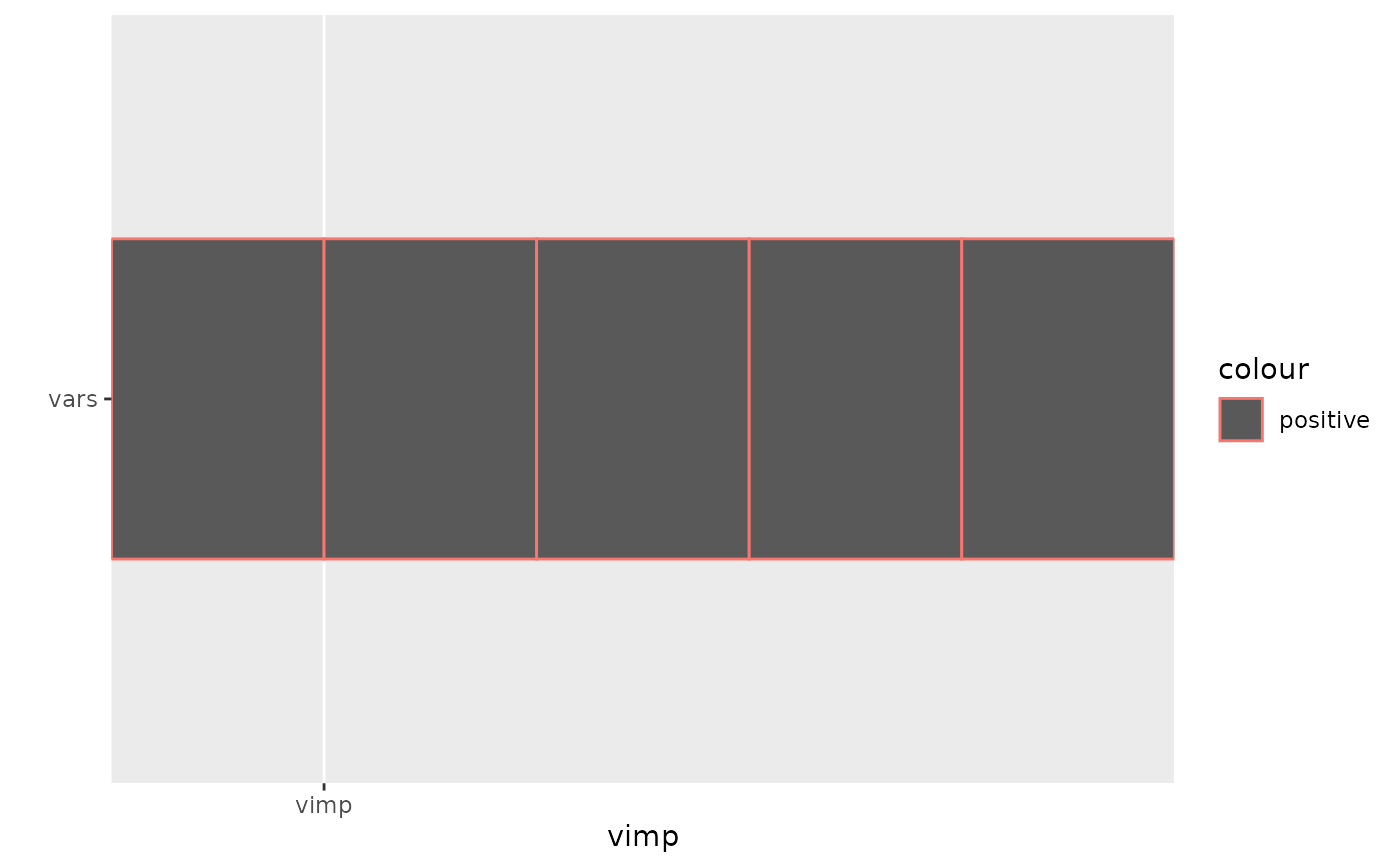 ## -------- Boston data
data(Boston, package = "MASS")
rfsrc_boston <- randomForestSRC::rfsrc(medv ~ ., Boston,
importance = TRUE
)
gg_dta <- gg_vimp(rfsrc_boston)
plot(gg_dta)
#> Warning: All aesthetics have length 1, but the data has 13 rows.
#> ℹ Please consider using `annotate()` or provide this layer with data containing
#> a single row.
## -------- Boston data
data(Boston, package = "MASS")
rfsrc_boston <- randomForestSRC::rfsrc(medv ~ ., Boston,
importance = TRUE
)
gg_dta <- gg_vimp(rfsrc_boston)
plot(gg_dta)
#> Warning: All aesthetics have length 1, but the data has 13 rows.
#> ℹ Please consider using `annotate()` or provide this layer with data containing
#> a single row.
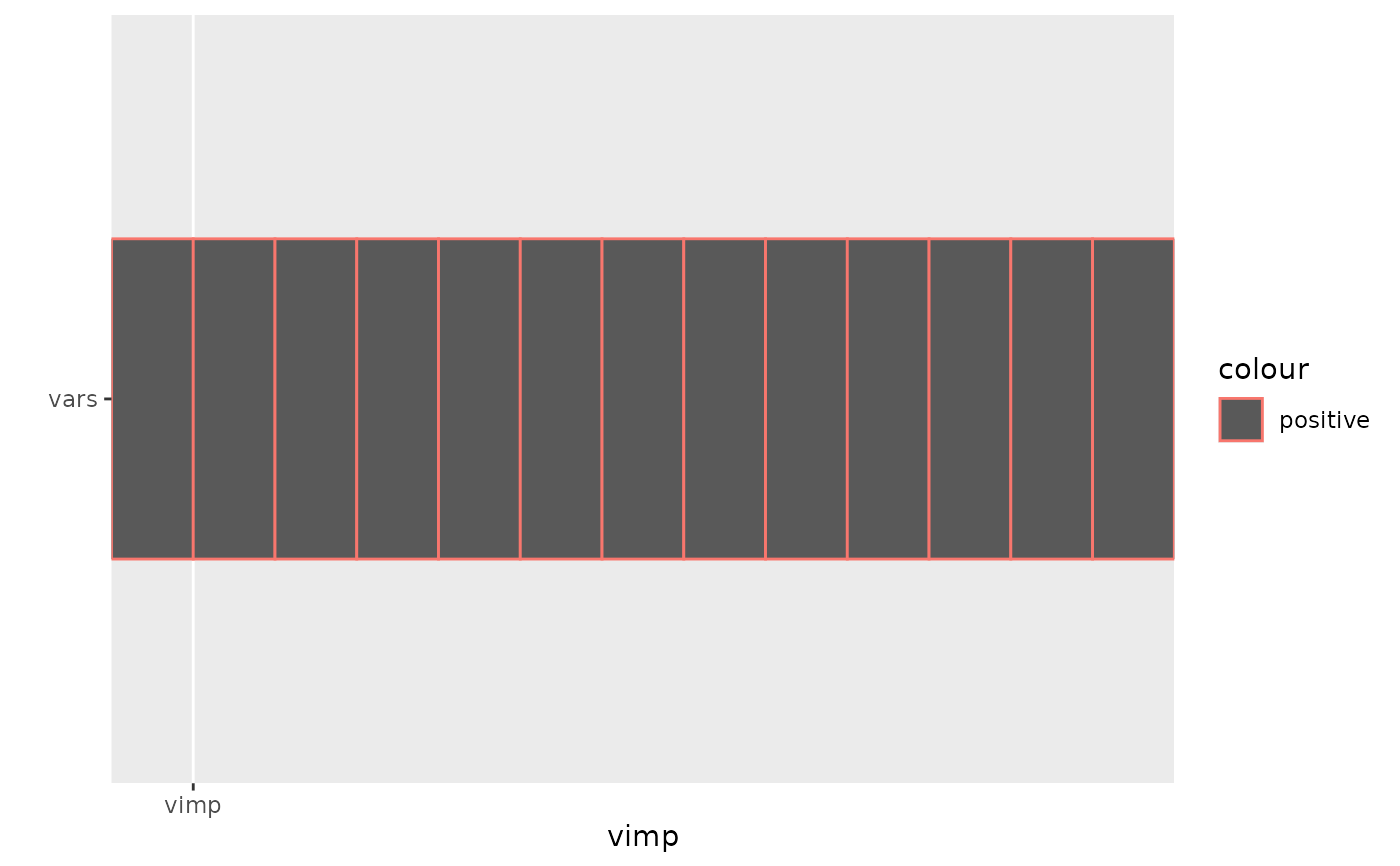 ## -------- Boston data
rf_boston <- randomForest::randomForest(medv ~ ., Boston)
gg_dta <- gg_vimp(rf_boston)
plot(gg_dta)
#> Warning: All aesthetics have length 1, but the data has 13 rows.
#> ℹ Please consider using `annotate()` or provide this layer with data containing
#> a single row.
## -------- Boston data
rf_boston <- randomForest::randomForest(medv ~ ., Boston)
gg_dta <- gg_vimp(rf_boston)
plot(gg_dta)
#> Warning: All aesthetics have length 1, but the data has 13 rows.
#> ℹ Please consider using `annotate()` or provide this layer with data containing
#> a single row.
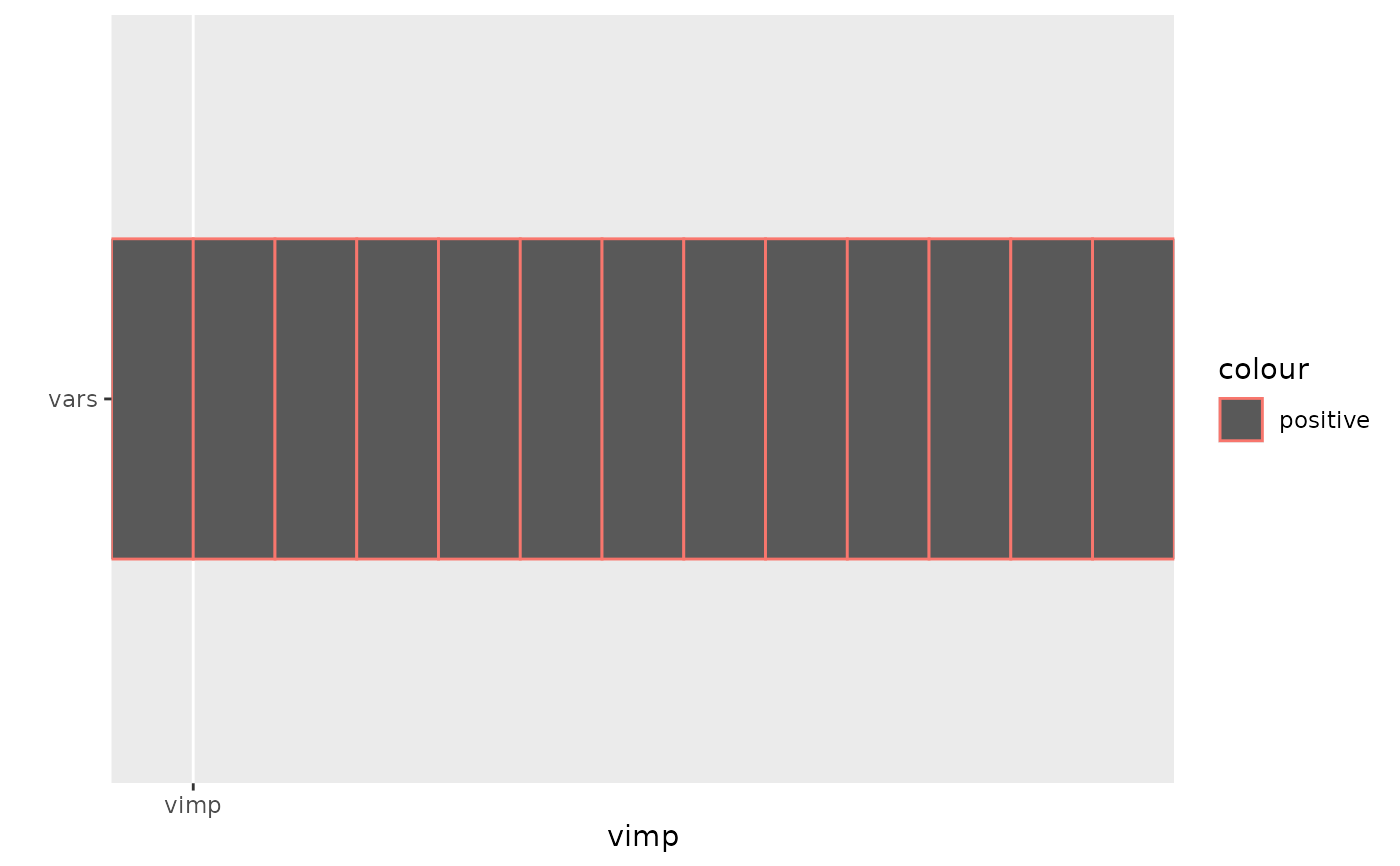 ## -------- mtcars data
rfsrc_mtcars <- rfsrc(mpg ~ .,
data = mtcars,
importance = TRUE
)
gg_dta <- gg_vimp(rfsrc_mtcars)
plot(gg_dta)
#> Warning: All aesthetics have length 1, but the data has 10 rows.
#> ℹ Please consider using `annotate()` or provide this layer with data containing
#> a single row.
## -------- mtcars data
rfsrc_mtcars <- rfsrc(mpg ~ .,
data = mtcars,
importance = TRUE
)
gg_dta <- gg_vimp(rfsrc_mtcars)
plot(gg_dta)
#> Warning: All aesthetics have length 1, but the data has 10 rows.
#> ℹ Please consider using `annotate()` or provide this layer with data containing
#> a single row.
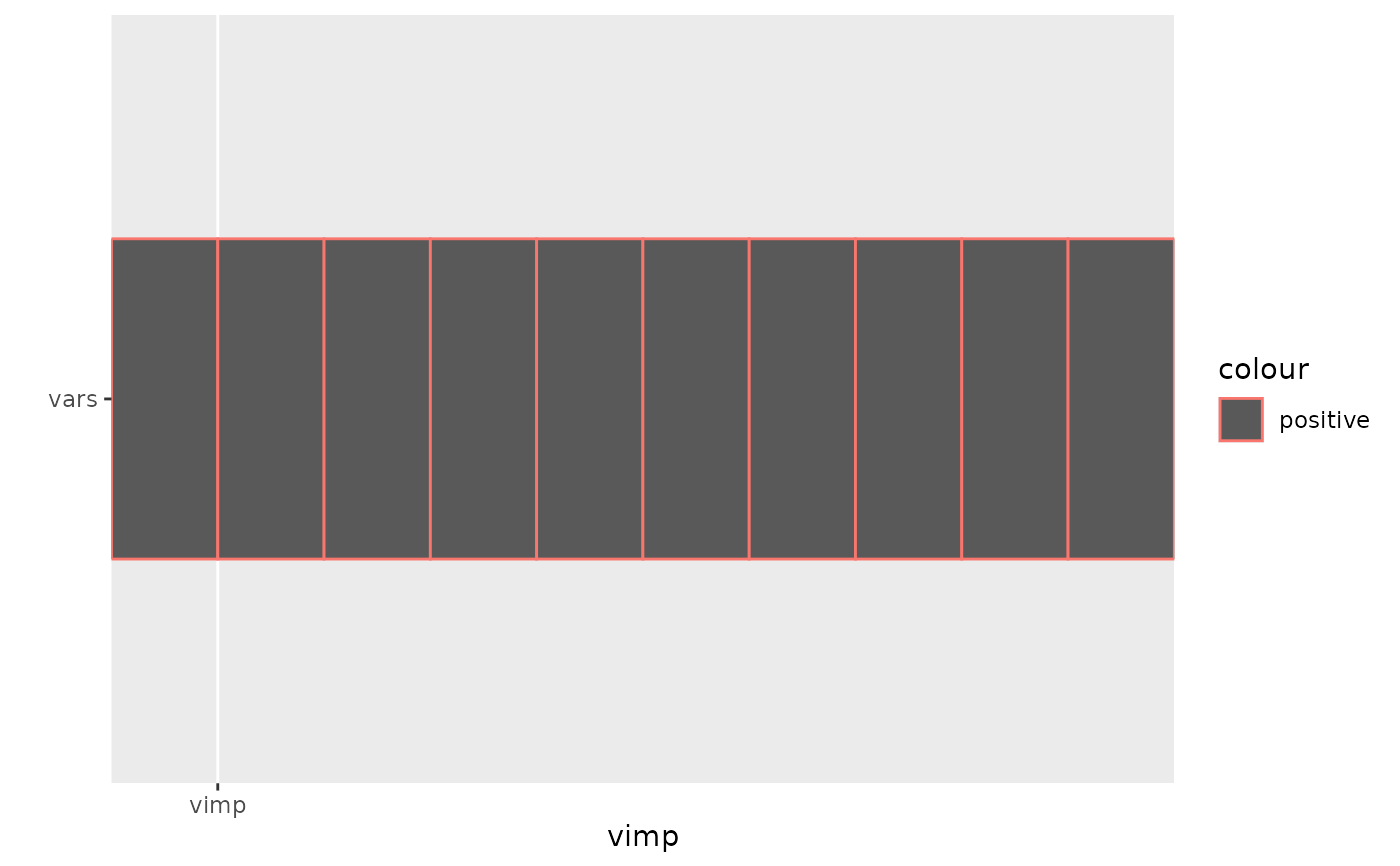 ## ------------------------------------------------------------
## survival example
## ------------------------------------------------------------
## -------- veteran data
data(veteran, package = "randomForestSRC")
rfsrc_veteran <- rfsrc(Surv(time, status) ~ .,
data = veteran,
ntree = 100,
importance = TRUE
)
gg_dta <- gg_vimp(rfsrc_veteran)
plot(gg_dta)
#> Warning: All aesthetics have length 1, but the data has 6 rows.
#> ℹ Please consider using `annotate()` or provide this layer with data containing
#> a single row.
## ------------------------------------------------------------
## survival example
## ------------------------------------------------------------
## -------- veteran data
data(veteran, package = "randomForestSRC")
rfsrc_veteran <- rfsrc(Surv(time, status) ~ .,
data = veteran,
ntree = 100,
importance = TRUE
)
gg_dta <- gg_vimp(rfsrc_veteran)
plot(gg_dta)
#> Warning: All aesthetics have length 1, but the data has 6 rows.
#> ℹ Please consider using `annotate()` or provide this layer with data containing
#> a single row.
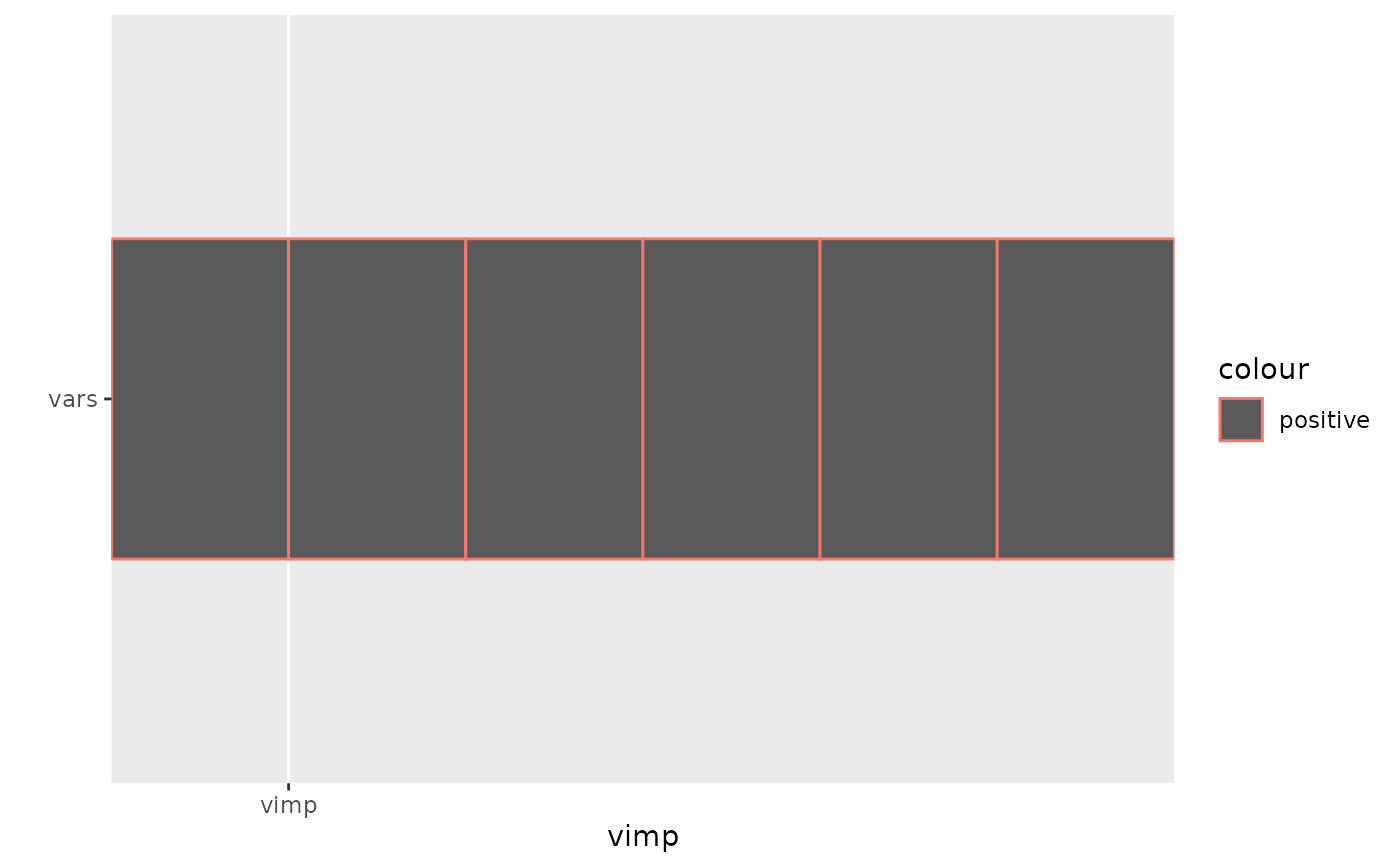 ## -------- pbc data
# We need to create this dataset
data(pbc, package = "randomForestSRC", )
#> Warning: data set ‘’ not found
# For whatever reason, the age variable is in days...
# makes no sense to me
for (ind in seq_len(dim(pbc)[2])) {
if (!is.factor(pbc[, ind])) {
if (length(unique(pbc[which(!is.na(pbc[, ind])), ind])) <= 2) {
if (sum(range(pbc[, ind], na.rm = TRUE) == c(0, 1)) == 2) {
pbc[, ind] <- as.logical(pbc[, ind])
}
}
} else {
if (length(unique(pbc[which(!is.na(pbc[, ind])), ind])) <= 2) {
if (sum(sort(unique(pbc[, ind])) == c(0, 1)) == 2) {
pbc[, ind] <- as.logical(pbc[, ind])
}
if (sum(sort(unique(pbc[, ind])) == c(FALSE, TRUE)) == 2) {
pbc[, ind] <- as.logical(pbc[, ind])
}
}
}
if (!is.logical(pbc[, ind]) &
length(unique(pbc[which(!is.na(pbc[, ind])), ind])) <= 5) {
pbc[, ind] <- factor(pbc[, ind])
}
}
# Convert age to years
pbc$age <- pbc$age / 364.24
pbc$years <- pbc$days / 364.24
pbc <- pbc[, -which(colnames(pbc) == "days")]
pbc$treatment <- as.numeric(pbc$treatment)
pbc$treatment[which(pbc$treatment == 1)] <- "DPCA"
pbc$treatment[which(pbc$treatment == 2)] <- "placebo"
pbc$treatment <- factor(pbc$treatment)
dta_train <- pbc[-which(is.na(pbc$treatment)), ]
# Create a test set from the remaining patients
pbc_test <- pbc[which(is.na(pbc$treatment)), ]
# ========
# build the forest:
rfsrc_pbc <- randomForestSRC::rfsrc(
Surv(years, status) ~ .,
dta_train,
nsplit = 10,
na.action = "na.impute",
forest = TRUE,
importance = TRUE,
save.memory = TRUE
)
gg_dta <- gg_vimp(rfsrc_pbc)
plot(gg_dta)
#> Warning: All aesthetics have length 1, but the data has 17 rows.
#> ℹ Please consider using `annotate()` or provide this layer with data containing
#> a single row.
## -------- pbc data
# We need to create this dataset
data(pbc, package = "randomForestSRC", )
#> Warning: data set ‘’ not found
# For whatever reason, the age variable is in days...
# makes no sense to me
for (ind in seq_len(dim(pbc)[2])) {
if (!is.factor(pbc[, ind])) {
if (length(unique(pbc[which(!is.na(pbc[, ind])), ind])) <= 2) {
if (sum(range(pbc[, ind], na.rm = TRUE) == c(0, 1)) == 2) {
pbc[, ind] <- as.logical(pbc[, ind])
}
}
} else {
if (length(unique(pbc[which(!is.na(pbc[, ind])), ind])) <= 2) {
if (sum(sort(unique(pbc[, ind])) == c(0, 1)) == 2) {
pbc[, ind] <- as.logical(pbc[, ind])
}
if (sum(sort(unique(pbc[, ind])) == c(FALSE, TRUE)) == 2) {
pbc[, ind] <- as.logical(pbc[, ind])
}
}
}
if (!is.logical(pbc[, ind]) &
length(unique(pbc[which(!is.na(pbc[, ind])), ind])) <= 5) {
pbc[, ind] <- factor(pbc[, ind])
}
}
# Convert age to years
pbc$age <- pbc$age / 364.24
pbc$years <- pbc$days / 364.24
pbc <- pbc[, -which(colnames(pbc) == "days")]
pbc$treatment <- as.numeric(pbc$treatment)
pbc$treatment[which(pbc$treatment == 1)] <- "DPCA"
pbc$treatment[which(pbc$treatment == 2)] <- "placebo"
pbc$treatment <- factor(pbc$treatment)
dta_train <- pbc[-which(is.na(pbc$treatment)), ]
# Create a test set from the remaining patients
pbc_test <- pbc[which(is.na(pbc$treatment)), ]
# ========
# build the forest:
rfsrc_pbc <- randomForestSRC::rfsrc(
Surv(years, status) ~ .,
dta_train,
nsplit = 10,
na.action = "na.impute",
forest = TRUE,
importance = TRUE,
save.memory = TRUE
)
gg_dta <- gg_vimp(rfsrc_pbc)
plot(gg_dta)
#> Warning: All aesthetics have length 1, but the data has 17 rows.
#> ℹ Please consider using `annotate()` or provide this layer with data containing
#> a single row.
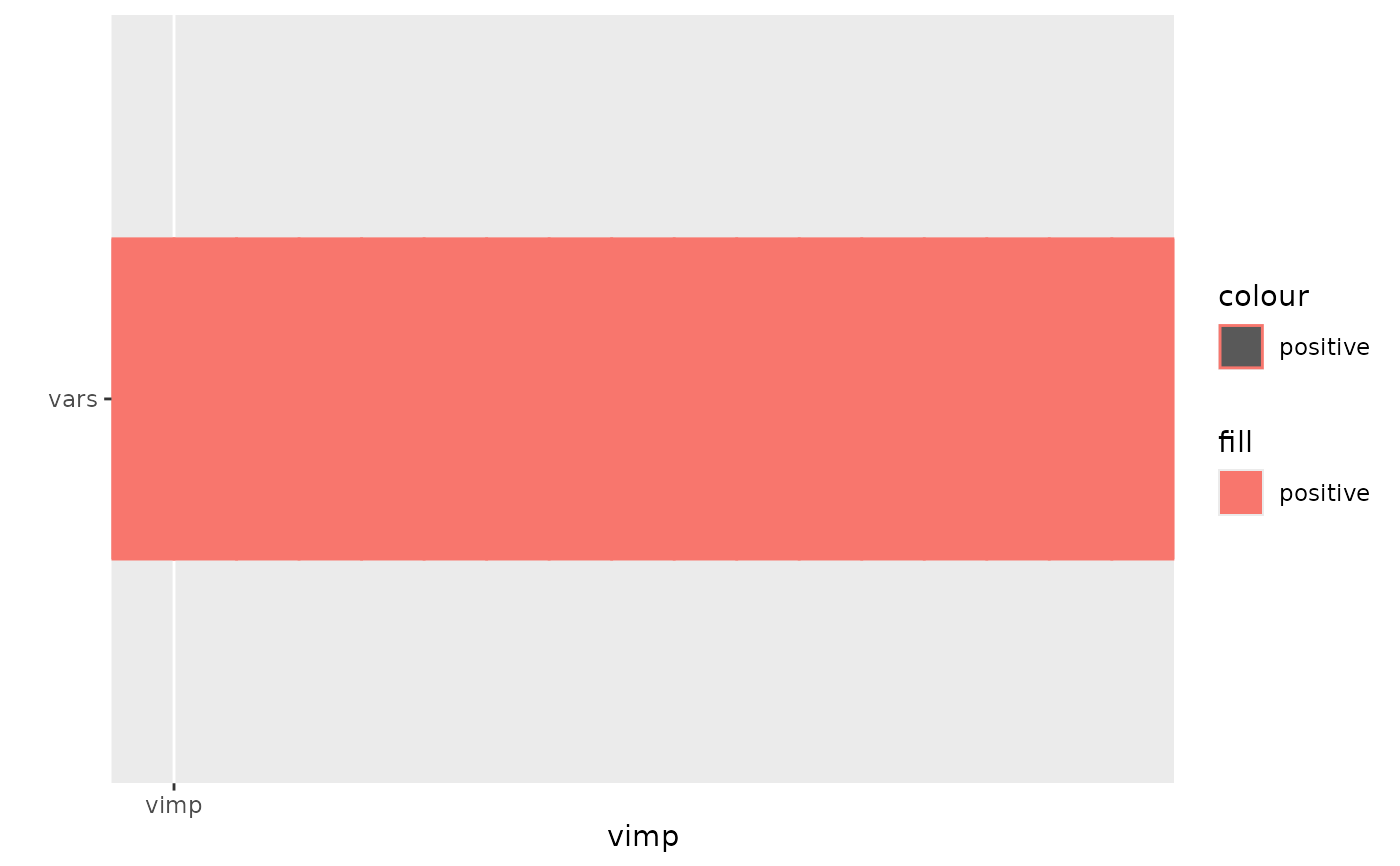 # Restrict to only the top 10.
gg_dta <- gg_vimp(rfsrc_pbc, nvar = 10)
plot(gg_dta)
#> Warning: All aesthetics have length 1, but the data has 10 rows.
#> ℹ Please consider using `annotate()` or provide this layer with data containing
#> a single row.
# Restrict to only the top 10.
gg_dta <- gg_vimp(rfsrc_pbc, nvar = 10)
plot(gg_dta)
#> Warning: All aesthetics have length 1, but the data has 10 rows.
#> ℹ Please consider using `annotate()` or provide this layer with data containing
#> a single row.
